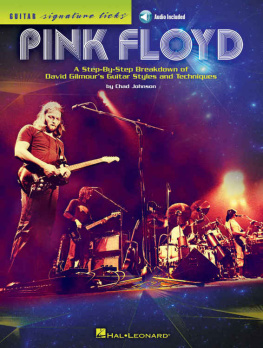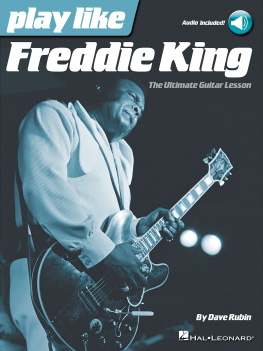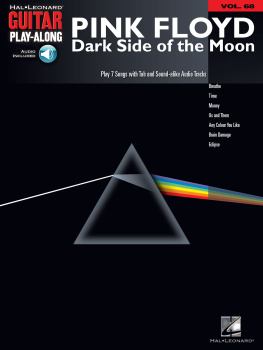7777 W. Bluemound Rd. P.O. Box 13819 Milwaukee, WI 53213
Infringers are liable under the law.
Introduction
Pink Floyd is a once-in-a-generation phenomenon. The idea that a band could be so blatantly original from the very beginning while still achieving such massive, worldwide commercial success is simply unheard of. Even the Beatles, who certainly achieved the freedom to express themselves as they saw fit while still enjoying unrivaled commercial success, started off much more meekly, working within the confines of their chosen genre and slightly bending the rules at first to find their niche. Pink Floyd, however, never bothered to conform to any established structures; they were art/space/psychedelic rock from the beginning, and they managed to amass a huge cult following doing just that. That cult following, of course, would eventually grow into one of the biggest fan bases the world has ever known.
Originally a four piece consisting of students Syd Barrett (guitar, vocals), Roger Waters (bass), Richard Wright (keyboards), and Nick Mason (drums), the band formed in 1965, when Barrett joined Waters, Mason, and Wright, who were then performing as the Tea Set. When they were booked on a show with another band known as the Tea Set, Barrett suggested the name Pink Floydan amalgamation of blues artists Pink Anderson and Floyd Council, both of whose records Barrett ownedand the band became known as the Pink Floyd Sound. In March of 1966, their new manager, Peter Jenner, suggested they drop Sound from their name, and they became known as simply Pink Floyd. Originally, they played R&B covers almost exclusively, but by late 1966, they had begun to introduce an increasing amount of Barrett originals. Their live shows included extended improvisations, wild sound effects, and increasingly complex light shows, which only heightened the psychedelic nature of their sound.
In 1967, the band signed to EMI with a 5,000 advance (slightly under $8,000) and released the single Arnold Layne, with Candy and a Currant Bun as the B-side. Despite being banned by some stations for its reference to cross-dressing, the single reached #20 in the U.K. That song was bested by their follow-up, See Emily Play, which climbed to #6, and they began making appearances on popular TV shows, including Top of the Pops , greatly expanding their fan base. It wouldnt be long, though, before Barretts increasing intake of LSD began to take its toll.
In August of 1967, the band released its debut album for EMI, The Piper at the Gates of Dawn , which peaked at #6 in the U.K. Though the band was still drawing big crowds in concert, when Syd was unable to perform liveat one show, he simply stood there with his guitar strapped on and his arms hanging to his sidehis mental instability could no longer be ignored. His condition only grew worse throughout the year, and by the end of 1967, the band decided they could no longer continue as such. They brought in David Gilmour as the fifth member, with the intention of him covering for any of Barretts shortcomings at live shows, and eventually aiming to move Barrett into the role of non-performing songwriter. That plan didnt hold up long, though, and by March of 1968, Barrett had agreed to leave the band. This also meant a change in management, as the bands current managers, Peter Jenner and Andrew King, decided to represent Barrett, whom they considered the creative genius of the band. Steve ORourke, assistant to the bands booking agent at the time, Bryan Morrison, became the bands personal manager.
In June of 1968, the band released its second album, A Saucerful of Secrets . Though the album contained one Barrett composition, Jugband Blues (his final composition on record with the band), the majority of composition duties fell on Waters, with Wright also composing two songs. Though they were encouraged by EMI to produce their own music, producer Norman Smith expressed some dissatisfaction with some of their work and even played drums on one track when he felt that Mason wasnt pulling his weight. The album reached #9 on the U.K. charts and resulted in the bands first lengthy U.S. tour, performing with the Who and the Soft Machine. The single Point Me at the Sky performed poorly, however, and it would be their last single release for a while.
With 1969s Ummagumma , the band pushed the boundaries of popular music. A double LP, the first disc contained live performances of pre-released material (singles or album tracks), while the second disc allowed each member to express himself fully with several experimental tracks each. No singles were released, but it peaked at #5 in the U.K. and made a showing in the U.S., at #74. It has since gone on to become one of the more celebrated works from the bands early period. Less than a year later, the band released Atom Heart Mother (1970). Though quite loathed by most of the band itself, it became their first #1 in the U.K. and hit #55 in the U.S. And though not as sprawling as Ummagumma , the album was no more accessible and is largely praised only by true cult fans of the band.
After an extensive American and European tour in 197071, the band began work on a new album. The resultant Meddle , released in October of 1971, displayed a more prominent Gilmour influence on the band and sounded decidedly more focused than Atom Heart Mother . Of course, it still contained an epic track, the 23-minute Echoes, but the album felt a bit more unidirectional in general and was a precursor of the bands future work. It reached #3 in the U.K. and #70 in the U.S.
In May of 1972, the band entered Abbey Road studios with engineer Alan Parsons. Over the next eight months, they recorded what would not only become their commercial breakthrough, but also one of the most successful albums of all time. The Dark Side of the Moon topped the charts on both sides of the Atlantic and remained on the Billboard charts for more than 14 consecutive years ! Selling over 50 million albums worldwide, The Dark Side of the Moon is the bands best-selling album and one of the most beloved musical recordings in history. Its been covered, in its entirety, in concert by numerous artists, including Phish and Dream Theater, and has been the subject of dozens of tribute albums. It also marked the bands return to the practice of releasing singles (Time and Money). Though neither did significantly well on the charts at the time, both songsnot to mention most cuts on the albumhave become classic rock staples. After the worldwide success of the album, the band cut ties with their U.S. label, Capitol Records, and negotiated a contract with Columbia Records for which they received a $1 million advance.
In early 1975, after finishing their tours for Dark Side , the band began work on a new album. Due to numerous factorsdisillusionment and exhaustion from the whirlwind success of Dark Side , Nick Masons marriage falling apart, etc.progress was slow going at first. Eventually, Waters decided to work with a new idea that theyd been honing in concert, based on a four-note motif that Gilmour had once played, which had reminded Waters of Syd Barrett (for some unknown reason). This would eventually become Shine On You Crazy Diamond, which helped set the tone for the new album. In a bizarre incident, Syd Barrett made a surprise, unannounced visit to the studio during the recording. Overweight and completely bald, the band didnt recognize him at first, and the event proved quite traumatic for the bandparticularly Waters. Barrett attended Gilmours wedding the next day, but left without saying goodbye, never to be seen again by any member of the band. With the event still fresh on the mind of Waters, he finished composing the lyrics of the album. With the lengthy Shine On You Crazy Diamond, Parts 15 and Parts 69 bookending the album, three more accessible tracksWelcome to the Machine, Have a Cigar, and Wish You Were Herefilled out Wish You Were Here (1975). Have a Cigar marks the firstand onlytime the band has featured a guest lead vocalist. Folk singer Roy Harper, who happened to be tracking in another room at the same time, asked for a shot when Rogers wasnt able to perform to his liking and Gilmour declined. Like Dark Side , the album topped the charts on both sides of the pond, though it wasnt the phenomenon that its predecessor was.











